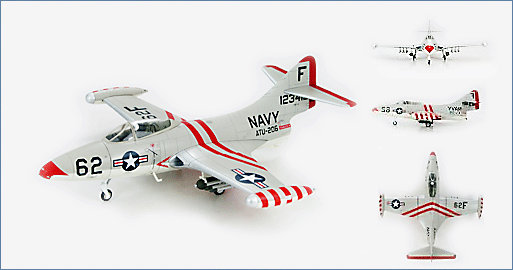Air Power Series>1:48 die-cast display model>F9F>HA7203
Grumman F9F-2 "Panther" ATU-206, NAS Pensacola, 1956

General Background
The F9F Panther entered service in 1949. It was the first Grumman jet fighter, first Carrier-Borne Navy jet fighter in combat, first USN jet to shoot down an enemy airplane, first jet aircraft used by the Blue Angels. A total of 1,382 F9Fs were made. VF-781 was the first squadron to volunteer for combat in Korea and were 100% volunteers earning them the name “Pacemakers”. The F9F flew 78,000 sorties with VF-781 flying 2,721 of them without a single loss of life. The Panther was removed from front-line service in 1956
The Aircraft
The brightest and most colorful paint schemes usually are found on drones and training aircraft. In stark contrast to the light gull grey over white these trainers were adorned with big bold red stripes to make them more visible. Approaching the end of its military life the F9F-2 123412 was assigned to ATU-206 located at NAS Pensacola Advanced Training Unit. This is where pilots went to hone their skills. Pensacola was selected because of its location that provided mile after mile of open water without obstructions.
Specifications :
Engine: |
1 X Pratt & Whitney J42-P-6/P-8 turbojet |
| Rated at – 5,000 lb.s.t. for takeoff dry | |
| 5,950 lb.s.t. for takeoff with water injection | |
| Performance: | Maximum speed – 575 mph at sea level, 545 mph at 22,000 feet, 529 mph at 3,500 feet |
| Cruising speed – 487 mph | |
| Landing speed - 105 mph | |
| Initial climb rate – 5,140 feet per minute | |
| Service ceiling – 44,600 feet | |
| Normal range – 1,353 miles | |
| Dimensions: | Wingspan - 35 feet 3 inches |
| Length - 37 feet 3 inches | |
| Height - 11 feet 6 inches | |
| Wing area - 250 square feet. | |
| Weights: | Empty – 9,303 pounds |
| Combat - 14,235 pounds | |
| Gross - 16,450 pounds | |
| Take-off - 19,494 pounds maximum | |
| Internal fuel capacity: | 923 US gallons |
| Armament: | 4 X 20-mm cannon. |
| Under-wing loads of up to 2,000 pounds of bombs | |
| and rockets could be carried on eight under-wing racks. |

